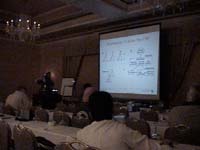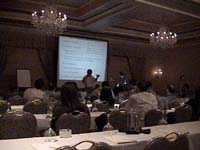Pacific
Symposium on Biocomputing
January 3 Report

I always hate rereading what I write. I tend to
find things that I want to change. After I had uploaded my report last
night, I checked it over one more time. And what do I read but "The Big
Island is one of the unique areas in the world." Unique means one of a
kind. You can not really add a modifier to something that is unique. What
I wrote was redundant. I promise not to do it again. Reread my reports,
that is.
Yesterday did not have a lot of science since
the meetings had not started. Today is filled with tutorials. There are
six of them, given two at a time for 3 hours each. It is usually an interesting
exercise to pick the 'right' one from each pair. Today, I am going to try
"Predictive Methods Using RNA Sequences" in the morning and "Information
Extraction from Scientific Texts."
 The
RNA one was pretty interesting. There is a lot of work being done examining
the tertiary structure of RNA sequences. It has real potential for therapeutics.
Many drugs bind to RNA better than they do to proteins. Unfortunately,
they do not bind to RNA with the specificity that they do with protein.
Knowing RNA structure would help in designing better drugs.
The
RNA one was pretty interesting. There is a lot of work being done examining
the tertiary structure of RNA sequences. It has real potential for therapeutics.
Many drugs bind to RNA better than they do to proteins. Unfortunately,
they do not bind to RNA with the specificity that they do with protein.
Knowing RNA structure would help in designing better drugs.
The main problem with determining RNA structure
is that, in contrast to proteins which have 2 torsion angles around the
backbone, RNA has six. There are also two different conformations of the
base, two conformations of the sugar moiety. There are only four bases
but a tremendous number of possible conformations.
In fact, the next three hours were spent showing
exactly how poorly computational methods work. Trying to align nucleotide
sequences is not very easy. Evolution conserves RNA structure not sequences.
Often pairs of nucleotides will be mutated, making BLAST type analysis
virtually impossible.
Even more so than proteins, RNA structural analysis
needs a tremendous amount of experimental data to verify structure. Until
recently, most of the data centered around tRNAs, because they were easy
to crystallize to get tertiary structure. The elucidation of the three
dimensional structures of both ribosome subunits and the complete ribosome
has provided a large number of possible structures for the databases. This
should help with further computational methods. But there is still a long
way to go before we can get a good handle on the structural comformations
RNA can take.
This part of the tutorial was reasonably useful
because it provided a good overview of the field and its problems. The
next part dealt with using XML to display RNA structure. Not nearly as
interesting but has some potential uses for the future, not only in this
field but in a lot of science endeavors. XML holds the promise of collating
different databases written in different formats. We shall see.
 The
other tutorial I attended was not as worthwhile. It was a discussion of
approaches to condense information out of scientific text, such as papers.
Unfortunately, the presentation left something to be desired. It was very
jargony with little real world examples. Mainly just obvious rules like
ambiguities can be a problem. There was a lot of discussion about how a
program can accurately parse a sentence and its negation (i.e. John runs
and John does not run). Careless programming may allow the computer to
see these two sentences as the same.
The
other tutorial I attended was not as worthwhile. It was a discussion of
approaches to condense information out of scientific text, such as papers.
Unfortunately, the presentation left something to be desired. It was very
jargony with little real world examples. Mainly just obvious rules like
ambiguities can be a problem. There was a lot of discussion about how a
program can accurately parse a sentence and its negation (i.e. John runs
and John does not run). Careless programming may allow the computer to
see these two sentences as the same.
What I got from this presentation is that information
extraction schemes are best used today to identify keywords and such for
bibliographic databases like Medline, but are a long way from intelligently
extracting text. But, we will have a session devoted to this so maybe current
approaches will have some surprises.
The scientific presentations start tomorrow. The
meeting officially opens at 8:20 am with coffee, juice and carbohydrates
from 7:30 to 8:15. I'll be loading up on the free stuff. This picture shows
what the food counters look like BEFORE the food arrives. Maybe tomorrow
I'll show what it looks like full.  The
morning sessions are on High Performance Computing for Computational Biology.
That looks to examine new methods to find genes in the databases. We will
also have the keynote lecture by David Haussler on A Working Draft of the
Human Genome. The afternoon will deal with protein evolution and the evening
will be roundtable discussions of the day's presentations. In previous
years, bottles of wine were provided, making these very free-wheeling discussions.
Hope they are this year.
The
morning sessions are on High Performance Computing for Computational Biology.
That looks to examine new methods to find genes in the databases. We will
also have the keynote lecture by David Haussler on A Working Draft of the
Human Genome. The afternoon will deal with protein evolution and the evening
will be roundtable discussions of the day's presentations. In previous
years, bottles of wine were provided, making these very free-wheeling discussions.
Hope they are this year.
Presenters - 3. Presentation Methods - Windows
with Powerpoint - 3. Arrgh!
 The
RNA one was pretty interesting. There is a lot of work being done examining
the tertiary structure of RNA sequences. It has real potential for therapeutics.
Many drugs bind to RNA better than they do to proteins. Unfortunately,
they do not bind to RNA with the specificity that they do with protein.
Knowing RNA structure would help in designing better drugs.
The
RNA one was pretty interesting. There is a lot of work being done examining
the tertiary structure of RNA sequences. It has real potential for therapeutics.
Many drugs bind to RNA better than they do to proteins. Unfortunately,
they do not bind to RNA with the specificity that they do with protein.
Knowing RNA structure would help in designing better drugs.

 The
other tutorial I attended was not as worthwhile. It was a discussion of
approaches to condense information out of scientific text, such as papers.
Unfortunately, the presentation left something to be desired. It was very
jargony with little real world examples. Mainly just obvious rules like
ambiguities can be a problem. There was a lot of discussion about how a
program can accurately parse a sentence and its negation (i.e. John runs
and John does not run). Careless programming may allow the computer to
see these two sentences as the same.
The
other tutorial I attended was not as worthwhile. It was a discussion of
approaches to condense information out of scientific text, such as papers.
Unfortunately, the presentation left something to be desired. It was very
jargony with little real world examples. Mainly just obvious rules like
ambiguities can be a problem. There was a lot of discussion about how a
program can accurately parse a sentence and its negation (i.e. John runs
and John does not run). Careless programming may allow the computer to
see these two sentences as the same.
 The
morning sessions are on High Performance Computing for Computational Biology.
That looks to examine new methods to find genes in the databases. We will
also have the keynote lecture by David Haussler on A Working Draft of the
Human Genome. The afternoon will deal with protein evolution and the evening
will be roundtable discussions of the day's presentations. In previous
years, bottles of wine were provided, making these very free-wheeling discussions.
Hope they are this year.
The
morning sessions are on High Performance Computing for Computational Biology.
That looks to examine new methods to find genes in the databases. We will
also have the keynote lecture by David Haussler on A Working Draft of the
Human Genome. The afternoon will deal with protein evolution and the evening
will be roundtable discussions of the day's presentations. In previous
years, bottles of wine were provided, making these very free-wheeling discussions.
Hope they are this year.